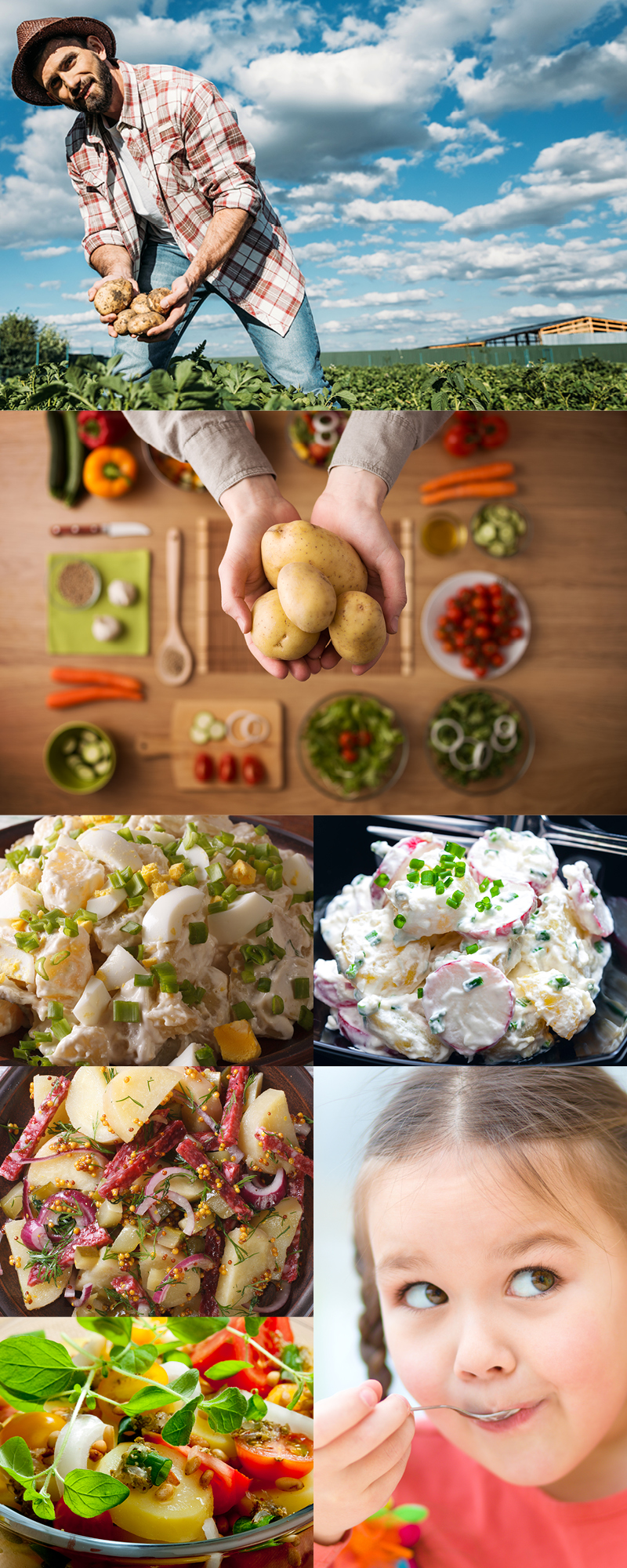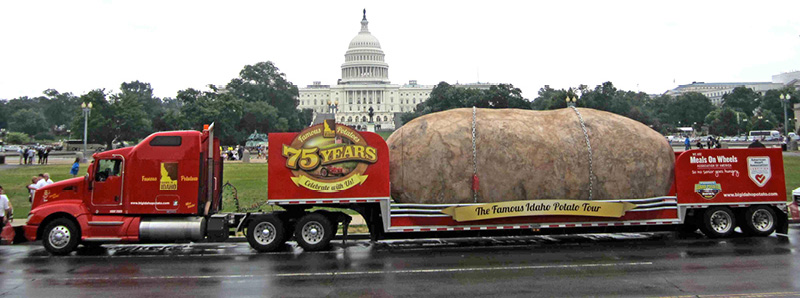Summer Must Be Here

Farm to kitchen to yum-m-m-m!!! Love that potato salad!
Over the holiday weekend, we were treated to some amazing weather here in NE Ohio, with the mercury reaching over 90 degrees – what a treat! And, like most families, we ventured out on to the back patio to enjoy the weather and my favorite part of summer – THE FOOD! Firing up the barbeque, roasting corn and veggies, I hit upon that one yummy side dish that just says “summer” – potato salad. (NOT ONLY AS A SIDE!) Yep, creamy, chunky, tasty potato salad. So, for my post this week, I thought I’d share a little history, some recipes and start a bit of competition, to find out who’s got the “best”. Best potatoes, best ingredients, best dressing. Add Eggs? Pickles? Mustard? Sour cream, yogurt or mayo? Hellman’s or Miracle Whip? Onions or scallions or chives? Now of course, I’m partial to Jackie’s approach, and also have a taste bud or two for when Mom makes her version, although I’m usually pretty easy to please, not when it comes to potato salad! Below you can find a few variations to experiment and send me your family favorites I can share with our blog community … and of course, don’t forget the pepper – (just isn’t right to eat without pepper! – or the occasional dollop of barbecue sauce!) Thanks Wikipedia and various food networks for their history and recipe versions.
- Potato salad is a dish made from boiled potatoes and a variety of other ingredients. It is generally considered a side dish, as it usually accompanies the main course.
- American potato salad most likely originated from recipes brought to the U.S. by way of German and European settlers during the nineteenth century. Basic ingredients for traditional American potato salad include cubed, boiled potatoes (typically russet potatoes), mayonnaise or a mayonnaise-like substitute such as yogurt or sour cream, yellow mustard and/or mustard powder (dry mustard), black pepper, salt, celery seed, sugar, dry dill, pickles (pickled cucumber), chives, red or white onion, green or red bell pepper, celery and sometimes chopped hard-boiled egg whites. Vegetable ingredients (not including the potatoes) are diced or chopped and incorporated raw. The salad is often topped with paprika and chives, and generally served cold or at room temperature.
- German potato salad, or “Kartoffelsalat” is served warm or cold and prepared with potatoes, bacon, vinegar, salt, pepper, vegetable oil, mustard, vegetable or beef broth, and onions. This style of potato salad is usually found in Southern Germany. Potato salad from northern Germany is generally made with mayonnaise and quite similar to its U.S. counterpart.
- With hundreds of varieties of potatoes to choose from, it can be daunting to figure out which one to use for potato salad. The type of potato matters. When shopping, potatoes are generally divided into three categories based on texture. For potato salad, you’ll want to stay away from starchy, thick-skinned potatoes like russets, which will fall apart during the cooking process. The best potatoes are Waxy: These thin-skinned potatoes have the least amount of starch and retain their shape well when boiled, making them our favorite for potato salad. Thin skins also mean that peeling is optional if you’re short on time or like a more rustic salad. What to look for: Red, new, or fingerling potatoes are the most common varieties.
- You can also use “In-Between” potatoes, also known as all-purpose potatoes, these have more starch than waxy potatoes, but will generally work well in most potato dishes, including potato salad. What to look for: White and Yukon Golds are reliable in-between potatoes to always have around.
Now that you are “thinking potatoes, did you know…
- Potatoes are the world’s fourth largest crop in terms of fresh produce, coming in behind only rice, wheat, and maize (corn). And they are the largest crop worldwide from the tuber family. Although this staple crop as we know it today has its most recent connections to Europe and European soil the very first potatoes actually originated in South America. After there was European contact with the Americas in the 1400’s and 1500’s the rest of the world was given access to the potato, allowing it to become the powerful staple field crop it is today. According to the guys who track things, the worldwide production of potatoes equaled approximately 750 BILLION POUNDS, making potatoes the fourth highest production crop in the world.
- Potatoes are often said to be made up of “empty calories”. This is not true. Potatoes are mostly recognized for their carbohydrate content. This is one of the key food types that our body requires daily. The carbohydrates in potatoes are predominately starch. A small but significant amount of this starch is resistant to digestion in the stomach and small intestine and, therefore, enters into the large intestine essentially intact. This resistant starch is considered to act with the same positive benefits that fiber does in the body; such as providing bulk, protecting against colon cancer, and increasing satiety (feeling of being satisfied or full) to name a few.
- Potatoes contain various important vitamins and minerals. By consuming a medium sized potato with the skin (therefore, most likely in the form of a baked potato) your body with receive almost 50% of its daily recommended amount of Vitamin C, around 20% of the potassium your body needs, and 10% of vitamin B6. Also included in this healthy spud are trace amounts of thiamin, riboflavin, folate, niacin, magnesium, phosphorus, iron, and zinc.
- The skin of the potato, as is fairly commonly known, is also a great source of fiber, providing an amount equivalent to most whole grain breads, cereals, and pastas. The old myth that all of a potato’s healthy elements are found in the skin is not true. Although the skin does house around half of the total dietary fiber of a potato, more than 50% of the healthy nutrients are found within the potato itself. So this makes me half right all of these years!!
- The method by which potatoes are cooked can result in a significant difference in the nutrient availability of the spud. Newer potatoes offer fewer toxic chemicals giving them a strong advantage over other potatoes and making them the best source of nutrition. While peeled potatoes that have been stored for a long time have a lower nutritional value, but they still would contain good levels of potassium and vitamin B.
- When it comes to preparing potatoes, there are many different ways to cook them and to use them as a part of your diet or fancy meal. You will find potatoes naked (no skin) or fully wrapped (skin on), you will find them chopped up or whole, and they will often be seasoned or unseasoned. Potatoes require to be cooked in some form as this breaks down the starch.
- Potatoes, believe it or not, can also be toxic to humans. They contain the toxic compounds known as glycoalkaloids which can cause headaches, diarrhea, cramping, and in very severe cases even comas or death. However, poisoning from potatoes occurs very rarely. In fact, cooking potatoes at high temperatures, which is almost always the case, works to partly destroy these toxic compounds. In the past, potatoes have also hurt humans in a different way; particularly the Irish during the great Irish potato famine when the potato, which was providing about 80 percent of the calories in each Irishman’s diet, had a crop failure. When a fungus destroyed almost the entire Irish crop of potatoes, nearly 1 of the 8 million people in Ireland died of starvation while 2 million more emigrated.
- When potatoes are newly harvested they are generally cured to thicken the skin. Prior to this curing the skin of a potato is quite delicate, and these types of potatoes known as “new potatoes” are said to be quite flavorful. Once harvested potatoes are either eaten by the gardener or farmer who has produced them, or they are sent away to be packaged and stored for you the consumer. The storage of potatoes is an intricate process as specially designed storage areas need to be carefully designed to keep potatoes alive and to slow their decomposition.
- And now for ingredients: depending on your taste buds, some favorites include: Celery, onion, eggs, mustard, pickle relish, radishes, bacon, carrots, yogurt or sour cream or different types of mayo, (Hellman’s!, not Miracle Whip), garlic salt, paprika, celery salt, chives, PEPPER! – just experiment and enjoy the variations.
Some great recipes to try: I WILL NOT BE GIVING UP JACKIE’S OR MOM’S!
Traditional: https://www.tasteofhome.com/recipes/mama-s-potato-salad
Southern: https://spicysouthernkitchen.com/southern-potato-salad/
Adventurous: https://www.saveur.com/gallery/Homemade-Potato-Salad-Recipes
Zany: https://www.mercurynews.com/2017/10/07/our-5-most-crazy-popular-potato-salad-recipes/

June 12, 2012—The Great Big Idaho® Potato Truck made a special appearance at the nation’s capitol in Washington, D.C. You can see what’s inside that giant spud HERE.



Leave a Reply
Want to join the discussion?Feel free to contribute!